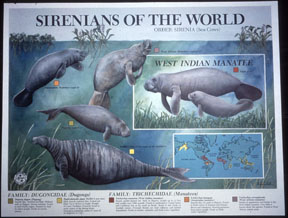|
A fifth, and largest, Sirenian of recent times, the Stellar Sea Cow (Hydrodamalis gigas), was also a member of the family Dugongidae. These enormous sirenians had evolved further to occupy the colder waters along the shores of the eastern Pacific ocean. These animals survived off the Aleutian islands until 1872, when the last animal of this species was killed for food , 28 years after being first sighted. Although there is only one living species of dugong, ancestors resembling them were diverse and widely distributed in the fossil record. Sirenians were most diverse in the Miocene (5-25 mya) when tropical conditions were widespread. The most widespread genus was Metaxytherium, which is considered ancestral to a subfamily of dugongids which included the Stellar Sea Cow. Metaxytherium lived world wide throughout the Mediterranean, Caribbean and western Pacific (SA & NA). Manatees and Dugongs appeared to have separated about 40 mya. (The conclusions here were gleaned from the many published studies of Dr. Daryl P. Domning) (Poster above provided by Save the Manatee Club) |
List of Specimens | Explore Collections | Brain Sections | Brain Evolution | Brain Development | Brain Circuitry | Brain Functions | Location and Use | Related Web Sites | Contact Us | Search MSU Database | Personnel | Home
